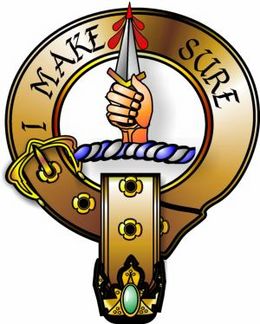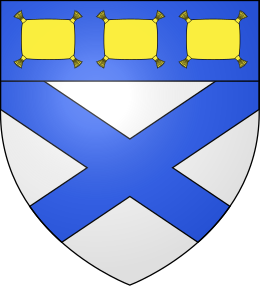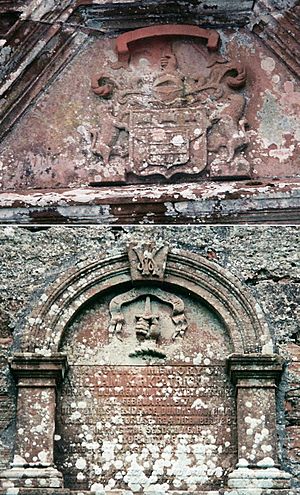Clan Kirkpatrick facts for kids
Quick facts for kids Clan Kirkpatrick |
|||
|---|---|---|---|
 |
|||
| Motto | I Mak Sikkar (I Make Sure) | ||
| Profile | |||
| Region | Lowlands | ||
| District | Dumfriesshire | ||
 |
|||
| Clan Kirkpatrick has no chief, and is an armigerous clan | |||
| Historic seat | Closeburn Castle | ||
|
|||
|
|||
|
|||

Clan Kirkpatrick is a Scottish clan from the Scottish Lowlands. You might also see the name spelled as Kilpatrick or Gilpatrick. This clan is officially recognized in Scotland. However, it does not currently have a clan chief. The Kirkpatrick name is also linked to Clan Douglas and Clan Colquhoun.
Contents
Clan Kirkpatrick History
Where the Clan Began
Old Stories
The clan's name comes from the church of Saint Patrick. This church is in the area of Closeburn in Dumfriesshire, Scotland. People traditionally believe the Kirkpatrick family has lived in these lands since the 800s.
First Records
The Kirkpatrick family first appears in official records in the 1100s. A man named Ivone de Kirkpatrick was a witness to an important document for Clan Bruce. Ivone also received a special paper from Alexander II of Scotland. This paper confirmed that he owned all his lands.
Fighting for Scottish Freedom
Roger Kirkpatrick was with Robert the Bruce when he met John "the Red" Comyn. This happened in a church in Dumfries. It is said that Bruce came out of the church, saying he thought he had hurt Comyn. Kirkpatrick then pulled out his dagger and said, I mak sikkar. This means "I make sure" and became the clan's motto. The clan's coat of arms also shows this story.
In 1314, Kirkpatrick went on a special trip to England. He traveled with Sir Neil Campbell of Clan Campbell. Because of his loyalty, the Kirkpatrick family received new lands called Redburgh. Sir Roger Kirkpatrick was very brave in 1355. He captured both Caerlaverock Castle and Dalswinton Castle from the English. In 1357, Kirkpatrick was sadly killed by a relative, Sir James Lindsay of Clan Lindsay. The clan leadership then passed to a nephew, Sir Thomas Kirkpatrick. In 1409, he received the lands of Closeburn and Redburgh.
The 1500s and 1600s
In 1526, there was a disagreement with the Clan Charteris. Records show that John Charteris of Amisfield and his family were accused of a serious act against Roger Kilpatrick.
In 1542, another Sir Thomas Kirkpatrick was captured during the Battle of Solway Moss. His family's estate then went to a cousin. In 1685, Sir Thomas Kirkpatrick of Closeburn was given a special title. He became a Baronet of Nova Scotia because he supported Charles I of England. The large house built by the first Baronet later burned down. The fourth Baronet, Sir James, sold the Closeburn estates.
In 1563, John Carruthers of Howmains, from Clan Carruthers, was accused of attacking Kirkpatrick of Closeburn. He was also accused along with Edward Irvine of Bonshaw, chief of Clan Irvine.
William Kirkpatrick was from the Kirkpatrick of Conheath family branch. He was a merchant in Málaga, Spain. He married the oldest daughter of a Belgian baron. His great-granddaughter was Eugénie de Montijo. She later became the Empress of France when she married Napoleon III.
Clan Castles
- Closeburn Castle was the main home for the Kirkpatricks of Closeburn. They were the chiefs of Clan Kirkpatrick.
- Rockhall Tower was another castle that belonged to the Kirkpatricks.
- Torthorwald Castle also belonged to the Kirkpatricks.
- Tynron Doon is a site where a castle once stood. The Kirkpatricks held this castle. It is believed that Robert the Bruce stayed there after his meeting with John Comyn.
See Also
- Armigerous clan
- Colquhoun baronets
- Kirkpatrick baronets


